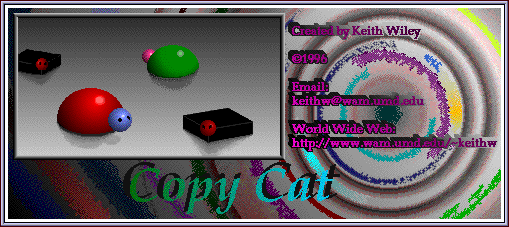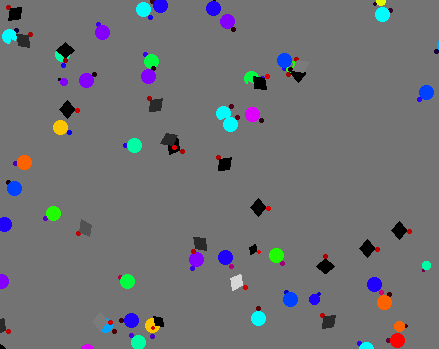Copy Cat
Copy Cat represented a major step in my programming. Since Bugs I not only learned a lot more about artificial life, but I also learned a lot about programming for the Macintosh. Copy Cat is much more user friendly and operating system friendly than Bugs was. Copy Cat is actually a specific experiment in which I attempted to produce mimicry, a phenomenon in nature used to demonstrate the power of evolution. Copy Cat 1.0 which I finished in November, 1995, fell desperately short in producing mimicry, but with some careful study and advice from my dad, a biologist, I have figured out what the main problems were with the program, and have completely fixed them in version 2.0, which faithfully produces mimicry every time the simulation is run. The creatures of Copy Cat are diverse and capable beings, even involving themselves in some vaguely interesting behavior such as watching predators chase prey all over the map. A short description of mimicryMimicry occurs when one organism looks like another in an attempt to gain some advantage of having that appearance without paying the cost that the original organism must pay for their appearance. To put it differently, say you have two populations of organisms (I am avoiding the word species because even though mimicry usually occurs in one species imitating another, it does occasionally happen in different populations of the same species). One population has a physical trait that they can benefit and one population does not possess that trait. If this trait has an influence on the organism's interactions with other organisms of whatever kind it may encounter, then the second population would benefit from this physical trait if they only looked like the first population. They don't actually have to possess the physical trait itself to benefit from it's advantages. There are a couple different kinds of mimicry. The most hailed example is that of a two species both of which are potential prey to a certain species of predators. One of the populations of prey are poisonous, one is not. The nonpoisonous species looks nearly identical to the poisonous species and so it happens that the predators can't tell that the nonpoisonous species is actually edible. All the predators know is that everything looks poisonous and must therefore be avoided. This is the example that Copy Cat attempts to reproduce. Another examples of mimicry occurs within a single species some individuals are poisonous, some are not, the benefits of the species' poison are reaped by the entire species. Another example is animals that mimic plants. Walking sticks are insects that when not moving, look strikingly like the branch on which they are walking. Sometimes plants mimic animals too. Several flowers mimic insects to seduce insects into "mating" with the flower for the purposes of spreading the flower's pollen. Another example is mimicing the predator of a would be predator. There is a catepillar that looks frightenly like a dangerous snake. A View of the Copy Cat World: 
Copy Cat is equipped with tons of powerful tools that let you manipulate the environment, including genetic engineering that lets you play with the genes and variables of individual creatures. In addition there are full color graphs and histograms of all the relevant data in the simulation which allow you to monitor populations, births, causes of deaths, trait distribution, and many other factors over an extensive period of time. 
Copy Cat is freeware and will run on any Macintosh computer. Extensive documentation is included. |